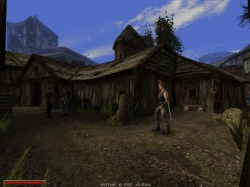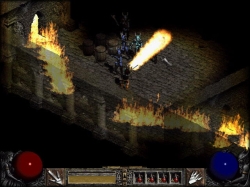Computer Role-Playing Games
Computer role-playing games ( CRPGs ), often shortened to simply role-playing games ( RPGs ), are a type of video or computer game that traditionally use gameplay elements found in paper-and-pencil role-playing games . Modern RPG games encompass a wide range of styles and types of engines and have significantly branched out.
 RPG gameplay elements can be found in real-time strategy games, first-person shooters , third-person shooters , and some other types such as massively multiplayer online games . However, games that are actually called just 'RPG', are usually limited to top-down perspective point-and-click and some third-person perspective types.
RPG gameplay elements can be found in real-time strategy games, first-person shooters , third-person shooters , and some other types such as massively multiplayer online games . However, games that are actually called just 'RPG', are usually limited to top-down perspective point-and-click and some third-person perspective types.
More recently, with the advent of games like Deus Ex and Warcraft 3 , the idea of what it means to be a RPG has become blurred. Many non-RPG games are increasingly featuring aspects traditionally seen in RPGs, such as a skill system, experience, and dilemmas. Meanwhile, many self-declared RPGs, such as the more recent Zelda games, dispense altogether with traditional RPG aspects. The expansion of traditional RPG elements into 3-D game engines is creating a myriad of hybrid game categories, crowding successors to earlier representations of CRPGs.
History
Role-playing video games began as an offshoot of early roguelike Unix games, themselves obviously inspired by paper-and-pencil role-playing games. Multiple-User Dungeons ( MUDs ) also fed many concepts and ideas into the role-playing genre. Text RPGs evolved from text adventures , the roguelikes and MUDs. Among the first were Akalabeth ( 1978 ), which gave rise to the well-known Ultima series and dnd , developed on the PLATO System .
The early Ultima and Wizardry games are perhaps the largest influence on the later console RPG games that are now popular. Many innovations of Ultima III: Exodus eventually became standards of almost all RPGs in both the console market (if somewhat simplified to fit the joystick ) and the PC market.
 The earliest console RPG was the Intellivision title AD&D Treasure of Tarmin ( 1982 ). Much later, in 1986 , Enix made the NES title Dragon Quest (called Dragon Warrior in North America ). This was followed shortly by ports of the computer RPGS Wizardry and Ultima III , and by Final Fantasy ( 1987 ) by Squaresoft . Both of these games proved popular and spawned a series of sequels. Both game series remain extremely popular today, Final Fantasy more so in North America, and Dragon Quest in Japan .
The earliest console RPG was the Intellivision title AD&D Treasure of Tarmin ( 1982 ). Much later, in 1986 , Enix made the NES title Dragon Quest (called Dragon Warrior in North America ). This was followed shortly by ports of the computer RPGS Wizardry and Ultima III , and by Final Fantasy ( 1987 ) by Squaresoft . Both of these games proved popular and spawned a series of sequels. Both game series remain extremely popular today, Final Fantasy more so in North America, and Dragon Quest in Japan .
Dragon Quest and Final Fantasy both borrowed heavily from Ultima. For example, leveling up and saving must be done by speaking to the king in Dragon Quest , and in order to rest and get healed, the characters must visit the king ( Dragon Quest ) or stay the night at an inn (both games). The games are played in a top-down perspective , much like the Ultima games, as well. The combat style in Dragon Quest was borrowed from another PC-based series, the Wizardry games.
Cultural differences
Due to cultural differences between developing companies based on their country of origin, there are now two certain "families" of graphical RPGs. The differences are primarily focussed on the graphics and storyline, but also on statistics systems, magic systems and the like. At the basic level, though, both are pretty much the same, with attributes, statistics and levels dominating gameplay and characters and personalities dominating the storyline.
 One of the families is the Japanese family of graphical RPGs with the Final Fantasy , Phantasy Star , Grandia and the Lunar series as clear examples. These games are often more colorful and bright than their western counterparts and include the eastern inclination to mix fantasy with spirituality. The characters in these games are usually anime -style with personalities ranging from both extremes of the spectrum. The storyline often involves an epic and final battle between the forces of good and evil, with the player nearly always fighting for the forces of good. The character-races in these kind of games are usually limited to a selection of humans, beastmen/women, espers (somewhat like elementals from the Dungeons and Dragons universe), elves and androids . AD&D based systems among these games are very rare, at best. These games frequently use a level-based advancement with little customization involved, with level 1 as the basic level of power in the game and level 99 as the top.
One of the families is the Japanese family of graphical RPGs with the Final Fantasy , Phantasy Star , Grandia and the Lunar series as clear examples. These games are often more colorful and bright than their western counterparts and include the eastern inclination to mix fantasy with spirituality. The characters in these games are usually anime -style with personalities ranging from both extremes of the spectrum. The storyline often involves an epic and final battle between the forces of good and evil, with the player nearly always fighting for the forces of good. The character-races in these kind of games are usually limited to a selection of humans, beastmen/women, espers (somewhat like elementals from the Dungeons and Dragons universe), elves and androids . AD&D based systems among these games are very rare, at best. These games frequently use a level-based advancement with little customization involved, with level 1 as the basic level of power in the game and level 99 as the top.
The other family of graphical RPGs is the western one, with Baldur's Gate , Diablo and Neverwinter Nights as good examples. These games are often more dark, almost gothic in design and art, and the characters featuring in these games are rendered or drawn in a more realistic way according to western styles. The personalities of the characters are more varied than those of their Japanese counterparts, without any real absolutes in morality. The storyline too is often darker, with the main theme being usually an ongoing struggle, almost never ending with a total victory over whatever enemy is given. The character-races are diverse and usually inspired by the books written by Tolkien . These graphical RPGs usually base their statistics systems on the AD&D d20 system , as well, though it is not uncommon for something completely different to be used.
![]() The earliest console RPG was the Intellivision title AD&D Treasure of Tarmin ( 1982 ). Much later, in 1986 , Enix made the NES title Dragon Quest (called Dragon Warrior in North America ). This was followed shortly by ports of the computer RPGS Wizardry and Ultima III , and by Final Fantasy ( 1987 ) by Squaresoft . Both of these games proved popular and spawned a series of sequels. Both game series remain extremely popular today, Final Fantasy more so in North America, and Dragon Quest in Japan .
The earliest console RPG was the Intellivision title AD&D Treasure of Tarmin ( 1982 ). Much later, in 1986 , Enix made the NES title Dragon Quest (called Dragon Warrior in North America ). This was followed shortly by ports of the computer RPGS Wizardry and Ultima III , and by Final Fantasy ( 1987 ) by Squaresoft . Both of these games proved popular and spawned a series of sequels. Both game series remain extremely popular today, Final Fantasy more so in North America, and Dragon Quest in Japan . 